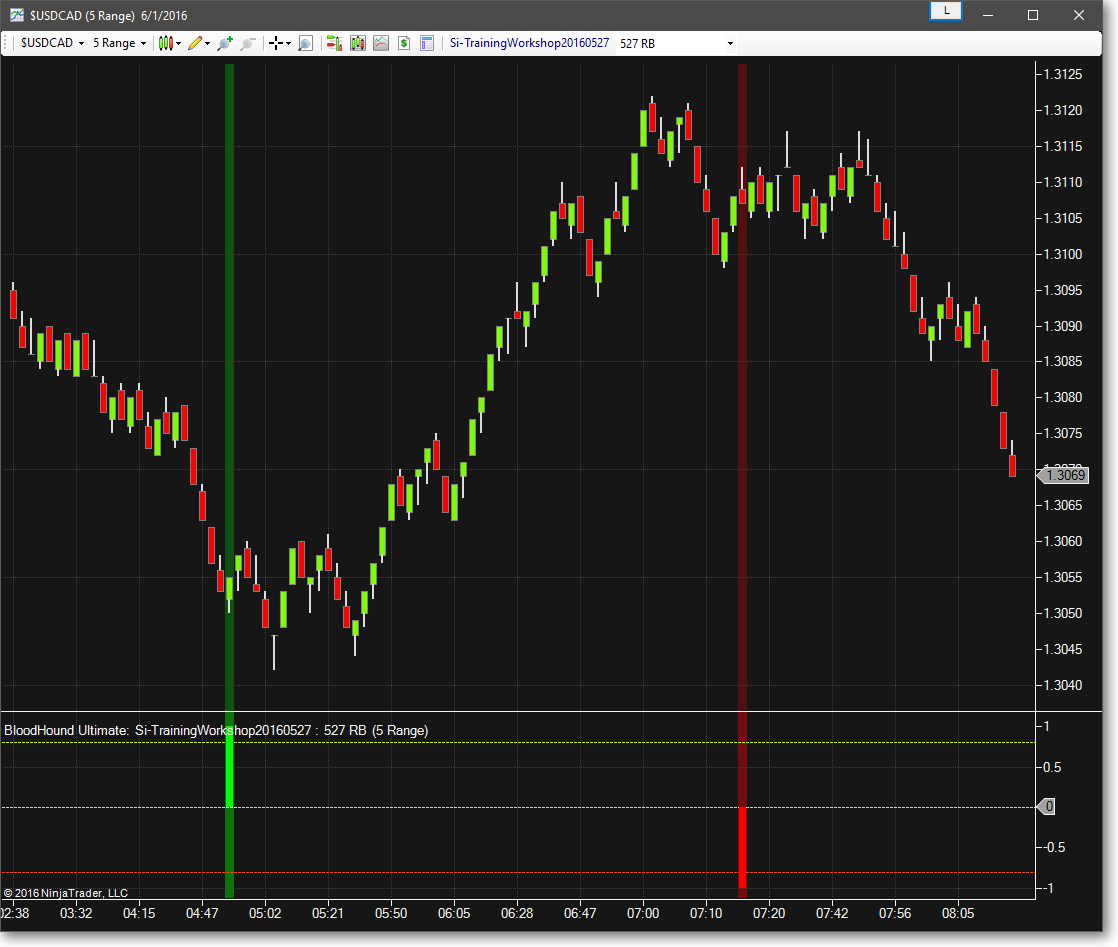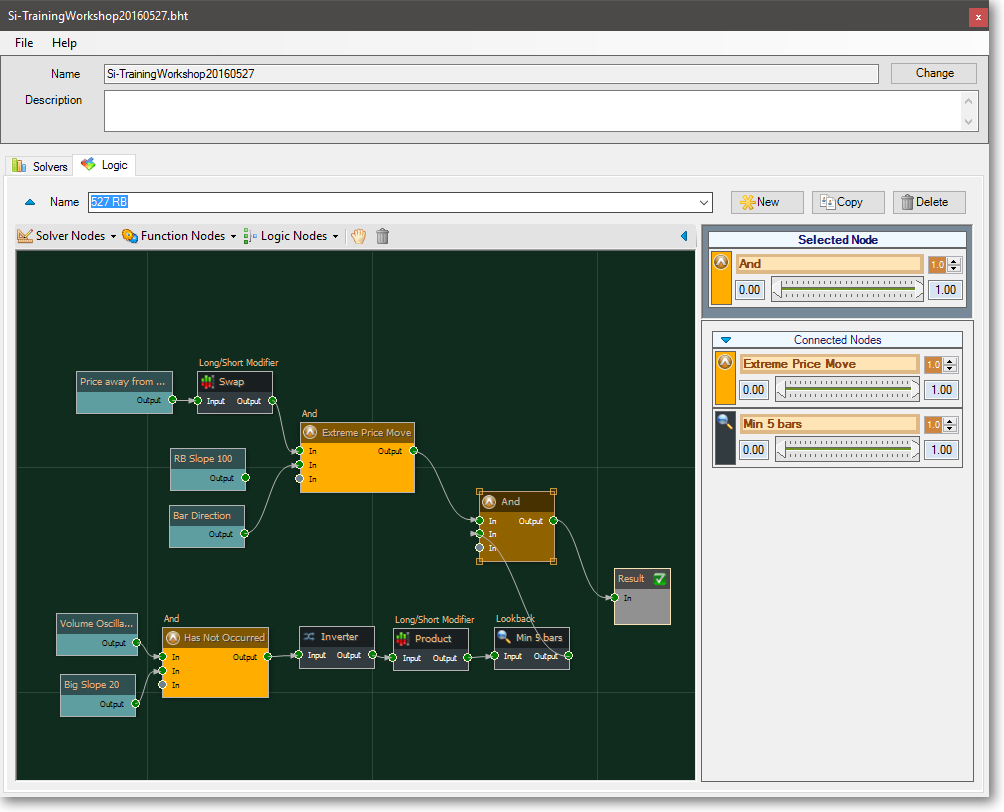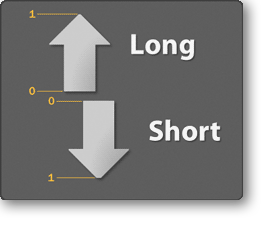BloodHound Overview & Properties
 Bloodhound is a user programmable indicator based on fuzzy logic. It takes observations from price action, indicator behavior and other factors as inputs and allows you to design custom logic constructs using logic templates to arrive at a calculated output. With BloodHound you can encode the behavior of any system, setup, filter or trade signal. BloodHound is a blank canvas – how you use it and how you configure it is entirely up to you. It is a powerful fuzzy logic calculator that has no limits on how complex your logic specifications may be. It allows you to define the inputs, and you define how they are used to arrive at a result.
Bloodhound is a user programmable indicator based on fuzzy logic. It takes observations from price action, indicator behavior and other factors as inputs and allows you to design custom logic constructs using logic templates to arrive at a calculated output. With BloodHound you can encode the behavior of any system, setup, filter or trade signal. BloodHound is a blank canvas – how you use it and how you configure it is entirely up to you. It is a powerful fuzzy logic calculator that has no limits on how complex your logic specifications may be. It allows you to define the inputs, and you define how they are used to arrive at a result.  For example, you may have a trading system with defined entry rules based on what’s happening with certain indicators and price bars on multiple time-frames. You can use BloodHound to describe your system in exact detail, painting your chart with long and short signals. These signals can also be fed into a NinjaTrader strategy dictating when to buy and sell. Your resulting strategy can then be easily modified by re-configuring BloodHound’s logic. This can be done in real-time, allowing you to change the behavior of your automated (or manually traded) system quickly and easily, without the need to update your strategy code. Strategies utilizing BloodHound can be brought into NinjaTrader’s Strategy Analyzer for back-testing. Again by modifying the BloodHound logic you can alter your strategy buy and sell signals without manipulating any code, resulting in a very rapid prototyping and back-testing cycle.
For example, you may have a trading system with defined entry rules based on what’s happening with certain indicators and price bars on multiple time-frames. You can use BloodHound to describe your system in exact detail, painting your chart with long and short signals. These signals can also be fed into a NinjaTrader strategy dictating when to buy and sell. Your resulting strategy can then be easily modified by re-configuring BloodHound’s logic. This can be done in real-time, allowing you to change the behavior of your automated (or manually traded) system quickly and easily, without the need to update your strategy code. Strategies utilizing BloodHound can be brought into NinjaTrader’s Strategy Analyzer for back-testing. Again by modifying the BloodHound logic you can alter your strategy buy and sell signals without manipulating any code, resulting in a very rapid prototyping and back-testing cycle.
BloodHound Output
 BloodHound’s default outputs are a value between 0 and 1 for the long side and the short side. BloodHound is actually calculating two separate evaluations for every bar. A confidence value for the long side, and a value for the short side. You can use these calculated values to represent trade signals, market filters, or to indicate that a condition is satisfied. For example, you can program BloodHound to give you a favorable signal when a certain condition happens on an indicator. When BloodHound outputs 1 for the long side, and 0 for the short side you can use that as a signal for a long trade, or alternatively use it as a filter to take only long trades. The choice is yours how you ultimately use the values calculated from bloodhound. The power comes from being able to quickly reconfigure BloodHound’s output by just manipulating the logic in real-time.
BloodHound’s default outputs are a value between 0 and 1 for the long side and the short side. BloodHound is actually calculating two separate evaluations for every bar. A confidence value for the long side, and a value for the short side. You can use these calculated values to represent trade signals, market filters, or to indicate that a condition is satisfied. For example, you can program BloodHound to give you a favorable signal when a certain condition happens on an indicator. When BloodHound outputs 1 for the long side, and 0 for the short side you can use that as a signal for a long trade, or alternatively use it as a filter to take only long trades. The choice is yours how you ultimately use the values calculated from bloodhound. The power comes from being able to quickly reconfigure BloodHound’s output by just manipulating the logic in real-time.
Confidence Values
Outputs are called confidence values, and their output ranges between 0 (zero) and 1. 0 being an unfavorable value, and 1 being favorable. BloodHound outputs decimal numbers as well. This can be thought of as degrees of favorability. For example, an output of 0.8 for the long side is considered more favorable than an output of 0.5. Note: it’s more than possible and sometimes desirable to have both the short and long side evaluate to the same value at the same time.You can configure how much greater one side has to be over the other side to be considered a valid signal in one particular direction. To do this change the Compare Long and Short Confidence value found in the BloodHound settings from the NinjaTrader Indicators window. A value of 1.5 means that the dominant side has to be at least 1.5 times greater than the other side to be considered a valid signal. For example, an output of 0.7 for the long side and 0.8 for the short side is not considered a valid short signal in this case because the short side is not at least 1.5 times greater than the long side. On the other hand, if the long side was 0.4 and the short side 0.8, that would be considered a valid signal. Valid signals in BloodHound are plotted as vertical colored stripes (called racing stripes) on your chart.
To do this change the Compare Long and Short Confidence value found in the BloodHound settings from the NinjaTrader Indicators window. A value of 1.5 means that the dominant side has to be at least 1.5 times greater than the other side to be considered a valid signal. For example, an output of 0.7 for the long side and 0.8 for the short side is not considered a valid short signal in this case because the short side is not at least 1.5 times greater than the long side. On the other hand, if the long side was 0.4 and the short side 0.8, that would be considered a valid signal. Valid signals in BloodHound are plotted as vertical colored stripes (called racing stripes) on your chart.
You can also set BloodHound to ignore the ratio between long and short signals by setting theCompare Long and Short Confidence to false.
Finally, above those two settings you see the Long Threshold and Short Threshold inputs. These are the minimum amounts that the long and short values must be before a confidence value is considered a signal. Thus a Long Threshold setting of 0.8 (the default) means that BloodHound will not consider the confidence value an actual signal unless the confidence value is at least 0.8 or greater. The same holds true for the Short Threshold setting on the short side.
Properties
▾ System Template
▾ Signal Alerts
▾ Debugging
NinjaTrader Properties
The following Properties sections Data Series, Setup, and Visual are added by NinjaTrader. They do Not come from BloodHound.
Click on the NinjaTrader red text below to go to the explanation for that property in the NinjaTrader Help Guide.
▸ Data Series
▸ Setup
NinjaTrader Tip: Calculate Property Inheritance
When using an indicator that requires the Setup » Calculate property to be set to 'On each tick' to run correctly (such as a volume profile or order-flow type of indicator), then NinjaTrader requires the hosting NinjaScript (i.e. BloodHound / BlackBird) Calculate property to also be set to 'On each tick' in order for that guest indicator to run correctly.
In other words, NinjaTrader takes the Calculate setting of the hosting NinjaScript and applies it to all the guest indicators used by the host. This is called property inheritance. NinjaTradere does not permit "mixing & matching" the Calculate property of host and guest indicators.




